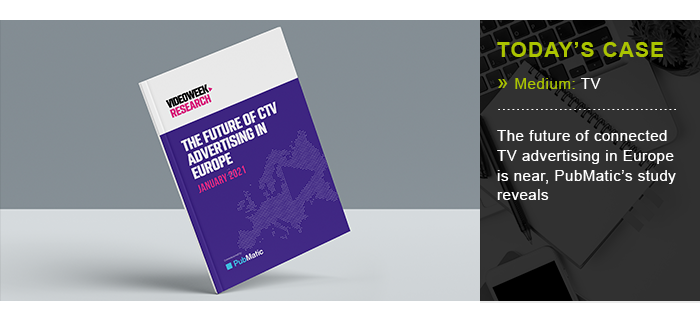Two-speed Europe moving forward
One of PubMatic's key findings is what can be described as "two-speed Europe". While large, global players are moving quickly to disrupt the European CTV advertising space, powered by unified content, technology and data infrastructure, local players move more slowly. The smaller players are nonetheless actively deploying next-generation TV advertising solutions, as CTV in Europe pushes from abstract intentions to tangible solutions.

Overall, respondents to PubMatic’s study agree that Europe as a region for CTV advertising lags behind the US. The good news is that in the last 12 months, markets have broken through the glass ceiling of innovation, with programmatic solutions moving from being an afterthought to its infancy. Over the past year, a host of new solutions has come to the market resulting in an unprecedented density of supply and demand in all of the markets analysed. The sell-side is now building a future where programmatic advertising is a driving force for future growth. On the buy-side, programmatic CTV advertising is approached as a means of bringing their own data to the mix.
Friction for buyers
The study examines the challenges of CTV advertising and buyers’ need for frictionless functionality across sell-side offerings. Here, streamlining is needed as inventory currently resides in multiple silos. “Traditional TV advertising owes its success in part to the ability to deliver harmonious reach across different broadcasters. In contrast, individual CTV advertising deployments from broadcasters and limits of technical interoperability currently restrict the ability to recreate this benefit,” PubMatic’s experts say on the matter.
The study specifies five key areas where development is needed to improve the user experience, deliver outstanding performance for brands and help publishers, and now CTV content providers, with maximum yield:
- Definitions need to be simplified for buyers and sellers to accelerate standard best practices and consistency throughout the supply and demand paths.
- Measurement needs to be standardised transparently and fairly.
- Broadcasters need to move beyond the focus on addressable linear TV solutions (e.g. HbbTV, STBs) to develop deep app economy expertise. In the future, this will be a significant battleground for consumer attention on CTV.
- Collaboration – individual CTV market participants need to understand that success comes from developing solutions and making decisions together, not by fighting for control of, e.g. data and measurement. Further experimentation and application of programmatic technologies - especially header bidding - and a more holistic approach to yield are required to secure additional spending.
- Developing CTV specific header bidding solutions is identified as an essential part of the transition. Unlike video and linear TV ads, CTV ads are served in pods meaning there are two or more sequential ads. To avoid overexposure of a single ad and ensure competitive separation, CTV-specific header bidding solutions are required to maximise campaign performance and viewer experience.
Education and talent required
To exploit the unique opportunities of CTV advertising, brands and agencies need to invest in building internal knowledge of CTV. Without education and talent, the channel's nuances will diminish the value for brands and content producers. To reach this goal, specialists need to play an active role in defining CTV and educating the broader ecosystem, not only the biggest players. Positively, the 60 in-depth interviews conducted for the study across agencies, advertisers, broadcasters and publishers, reveal that industry participants are already collaboratively working together to create a level playing field, fair competition, and thus increasing the value of CTV.
PubMatic’s research, The Future of CTV Advertising in Europe, is available in full here as well as special chapters on the researched countries in local languages.

